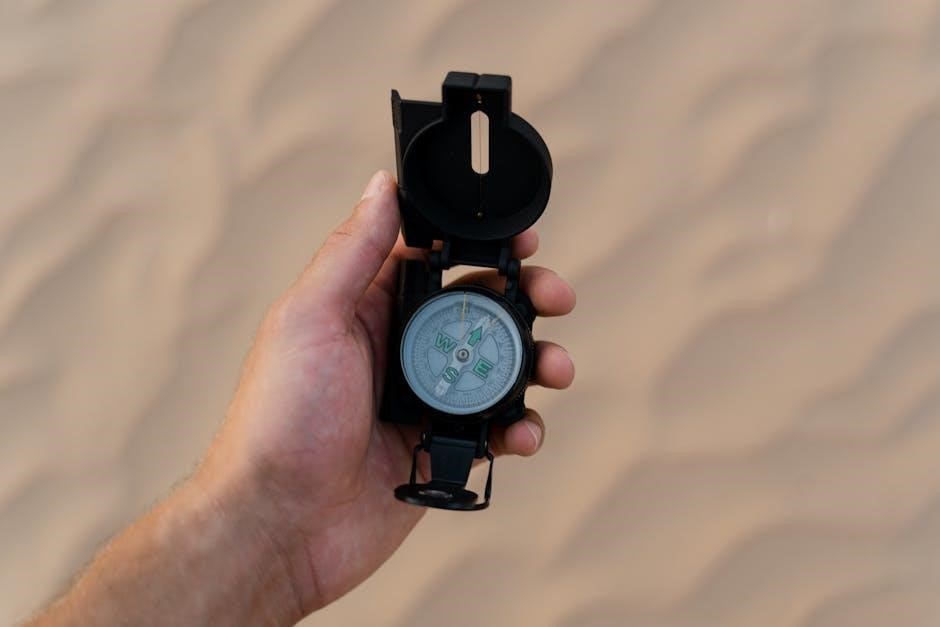Glocks are renowned for their internal safety mechanisms‚ eliminating the need for manual safeties. Their design relies on a trigger safety‚ firing pin safety‚ and drop safety to prevent accidental discharge‚ ensuring reliability and user confidence.
Overview of Glock’s Safety Mechanisms
Glocks are designed with a focus on internal safety mechanisms rather than manual safeties. These internal systems include a trigger safety‚ firing pin safety‚ and drop safety‚ all of which work automatically to prevent accidental discharges. The trigger safety ensures the pistol fires only when the trigger is fully pressed‚ while the firing pin safety blocks the firing pin from striking the primer unless the trigger is pulled. Additionally‚ Glocks are engineered to withstand drops without firing‚ enhancing their reliability in real-world scenarios. These integrated safety features eliminate the need for a manual safety‚ creating a streamlined design that prioritizes simplicity‚ reliability‚ and ease of use.
Importance of Understanding Glock Safeties
Understanding Glock safeties is crucial for safe and effective use. Their unique design relies on internal mechanisms rather than manual safeties‚ ensuring the pistol operates reliably under stress. This design philosophy prioritizes simplicity and ease of use‚ reducing the risk of human error. Users must recognize that Glock’s safeties are automatically engaged and disengaged through trigger action‚ eliminating the need to manipulate a manual safety. Proper training and adherence to firearm safety rules are essential to prevent accidents. Misunderstanding these features can lead to unsafe handling‚ emphasizing the importance of education for Glock owners. By grasping how these safeties function‚ users can confidently carry and use their Glocks‚ relying on their engineered reliability to enhance personal security and performance in critical situations.
Do Glocks Have Manual Safeties?
Glocks do not have manual safeties. Instead‚ they rely on internal safety mechanisms‚ including a trigger safety‚ firing pin safety‚ and drop safety‚ to prevent accidental discharge.
Definition of Manual Safety in Firearms
A manual safety is a mechanical device on a firearm that‚ when engaged‚ prevents the weapon from firing even if the trigger is pulled. It is typically a lever or button that must be deliberately disengaged to allow the gun to fire. Manual safeties are designed to provide an additional layer of security‚ especially during holstering‚ handling‚ or carrying‚ by physically blocking the trigger or firing mechanism. They are commonly found on pistols and rifles but vary in design depending on the firearm manufacturer and model. The primary purpose of a manual safety is to prevent accidental discharges‚ offering users enhanced control over the weapon’s operation.
Glock’s Approach to Manual Safeties
Glock’s approach to manual safeties is distinct and intentional. Unlike many other pistols‚ Glocks do not feature a manual safety lever. Instead‚ they incorporate internal safety mechanisms designed to prevent accidental discharges without requiring user intervention; This design philosophy emphasizes simplicity and reliability‚ eliminating the need for shooters to manage a manual safety during high-stress situations. Glock’s Safe Action system includes a trigger safety‚ firing pin safety‚ and drop safety‚ which collectively ensure that the firearm only fires when the trigger is intentionally pulled. This approach aligns with Glock’s commitment to enhancing usability and safety‚ making their pistols a popular choice for law enforcement and concealed carry. The absence of a manual safety is a deliberate choice to streamline operation and reduce potential errors in critical moments.
Comparison of Glock to Other Pistols with Manual Safeties
Glocks differ significantly from pistols equipped with manual safeties. While other firearms require users to disengage a safety lever before firing‚ Glocks rely solely on their internal Safe Action system. This eliminates the risk of forgetting to deactivate the safety in high-pressure situations‚ a common concern with manual safeties. Pistols like the 1911 or SIG Sauer often feature manual safeties‚ which some users prefer for an added layer of control. However‚ Glock’s design prioritizes simplicity and instinctive operation‚ appealing to those who value ease of use and reliability. The debate between the two approaches reflects differing priorities in firearm design‚ with Glock emphasizing internal mechanisms over external controls‚ a choice that has proven highly successful in both civilian and professional markets.

Internal Safety Mechanisms of Glocks
Glocks feature a trio of internal safeties: a trigger safety‚ firing pin safety‚ and drop safety. These mechanisms ensure the pistol fires only when the trigger is intentionally pulled‚ preventing accidental discharges and enhancing overall safety for users. The trigger safety blocks the trigger from moving unless pressed correctly‚ while the firing pin safety stops the firing pin from striking the primer unless the trigger is fully engaged. Additionally‚ the drop safety prevents firing if the gun is dropped‚ further safeguarding against unintended discharge. These integrated features make Glocks highly reliable and secure‚ eliminating the need for a manual safety lever.
Trigger Safety Explained
The trigger safety is a critical component of Glock’s Safe Action System‚ designed to prevent accidental discharges. It consists of a lever embedded within the trigger that must be intentionally pressed to allow the trigger to move rearward; This mechanism ensures the pistol cannot fire unless the trigger is deliberately pulled. The trigger safety is automatically engaged when the trigger is released‚ adding an extra layer of protection against unintended firing. This feature is particularly important in high-stress situations‚ as it minimizes the risk of accidental discharge even if the pistol is dropped or handled improperly. By integrating the safety into the trigger itself‚ Glock eliminates the need for a manual safety lever‚ streamlining the design while maintaining exceptional safety standards. This innovative approach has become a hallmark of Glock’s reputation for reliability and user-friendly functionality.
Firing Pin Safety Mechanism
The firing pin safety mechanism is another integral part of Glock’s internal safety system‚ ensuring the pistol fires only when intended. This mechanism physically blocks the firing pin from striking the primer unless the trigger is fully pressed. It automatically disengages when the trigger is pulled‚ allowing the firing pin to move forward and ignite the cartridge. This design prevents accidental discharge from drops or other impacts‚ as the firing pin cannot reach the primer without deliberate trigger activation. Unlike manual safeties‚ this mechanism operates seamlessly without requiring user intervention‚ enhancing both safety and operational efficiency. It is a testament to Glock’s commitment to creating firearms that are both reliable and secure‚ catering to users who prioritize instinctive handling and consistent performance in critical situations.
Drop Safety Features in Glocks
Glocks incorporate a robust drop safety feature to prevent accidental discharge if the pistol is dropped. This mechanism ensures the firing pin is blocked from striking the primer unless the trigger is intentionally pressed. The drop safety works in conjunction with the firing pin safety‚ providing an additional layer of protection against unintended ignition. Unlike manual safeties‚ this feature operates automatically‚ eliminating the need for user intervention. It is designed to withstand various impact scenarios‚ making Glocks highly reliable for concealed carry and duty use. This feature underscores Glock’s focus on safety‚ offering peace of mind to users without compromising accessibility or performance in high-stress situations.

Why Glocks Do Not Have Manual Safeties
Glocks omit manual safeties to streamline operation‚ reducing reliance on external levers that could hinder quick access in critical situations. Their internal mechanisms ensure safety without manual intervention.
Glock’s Design Philosophy
Glock’s design philosophy emphasizes simplicity‚ reliability‚ and ease of use. By eliminating manual safeties‚ Glocks streamline operation‚ reducing the need for external controls. This approach minimizes the potential for user error and ensures rapid deployment in critical situations. The absence of a manual safety lever aligns with the idea of intuitive handling‚ allowing users to focus on their environment rather than manipulating controls. This design choice reflects Glock’s commitment to creating firearms that are both safe and efficient‚ catering to the needs of law enforcement‚ self-defense‚ and recreational shooters who value simplicity and effectiveness. The philosophy centers on user-friendliness and dependability‚ making Glocks a preferred choice for many firearm enthusiasts.
Advantages of No Manual Safety
The absence of a manual safety on Glocks offers several advantages‚ primarily streamlined operation and reduced complexity. Without a manual safety‚ users avoid the risk of accidentally engaging or disengaging the safety during high-stress situations. This design simplifies the firearm’s handling‚ making it more intuitive for shooters of all skill levels. The elimination of a manual safety also reduces the likelihood of mechanical failure caused by improper safety manipulation. Additionally‚ Glocks’ internal safety mechanisms ensure the pistol cannot fire unless the trigger is intentionally pulled‚ providing inherent safety without the need for external controls. This approach enhances reliability and speed‚ making Glocks highly favored for self-defense and law enforcement applications where quick‚ decisive action is critical. The streamlined design also reduces the risk of the safety lever snagging on clothing or gear‚ further improving practicality for concealed carry. Overall‚ the lack of a manual safety contributes to the Glock’s reputation for simplicity‚ reliability‚ and ease of use‚ making it a preferred choice for many firearm enthusiasts and professionals alike.
Historical Context of Manual Safeties in Firearms
Manual safeties in firearms have evolved significantly over time‚ reflecting advancements in design and user needs. Early firearms‚ such as flintlocks‚ lacked manual safeties due to their mechanism and slower operation. As revolvers and semi-automatic pistols emerged in the 19th and early 20th centuries‚ manual safeties became more common to prevent accidental discharges‚ especially in military and law enforcement contexts. By the mid-20th century‚ the introduction of Glocks without manual safeties marked a shift towards internal safety mechanisms‚ emphasizing reliability under stress. This design change influenced the industry‚ with many modern pistols adopting similar approaches‚ balancing safety and operational efficiency. The historical progression from manual to integrated safeties highlights the evolution of firearm technology and user preferences‚ focusing on practicality and effectiveness in high-pressure situations.

The Debate Over Manual Safeties
The debate over manual safeties centers on their necessity. Proponents argue they offer an extra layer of control‚ while critics‚ including Glock enthusiasts‚ believe they’re unnecessary and can hinder quick access in emergencies.
Pros and Cons of Manual Safeties
Manual safeties offer an additional layer of control‚ reducing accidental discharges‚ especially in high-stress situations. They provide a clear visual and tactile confirmation that the firearm is secure‚ enhancing safety for novice users. However‚ they can hinder quick access in emergencies‚ as they require deliberate disengagement. Critics argue that manual safeties can be unreliable if not properly maintained or if the user is under stress‚ potentially leading to delays in critical moments. This trade-off between added security and potential delay is central to the debate‚ with Glock’s design emphasizing internal safeties over manual ones to ensure rapid deployment without compromise. This approach has split opinions‚ with strong arguments on both sides.
Expert Opinions on Glock’s Safety Design
Firearm experts widely praise Glock’s safety design for its reliability and effectiveness. The absence of a manual safety is intentional‚ as Glock’s internal mechanisms‚ such as the trigger safety‚ firing pin safety‚ and drop safety‚ ensure the pistol cannot fire unintentionally. Many experts highlight that these internal safeties are more consistent and less prone to human error than manual safeties‚ which can be forgotten or disengaged accidentally. Law enforcement and military professionals often prefer Glocks for their simplicity and readiness in high-stress situations. While some critics argue that manual safeties provide an extra layer of control‚ the overwhelming consensus is that Glock’s design prioritizes both safety and operational efficiency‚ making it a trusted choice for professionals and civilians alike. This approach has solidified Glock’s reputation as a leader in modern handgun design.
Shooter Preferences and Manual Safeties
Shooter preferences regarding manual safeties vary widely. Some shooters‚ particularly those trained on pistols with manual safeties‚ may feel more comfortable with the tangible control they provide. Others‚ especially those accustomed to Glocks‚ appreciate the streamlined design without manual safeties‚ which reduces the chance of forgetting to disengage a safety under stress. For concealed carriers‚ the absence of a manual safety simplifies the draw process‚ minimizing potential delays. Ultimately‚ shooter preferences often align with their training‚ experience‚ and specific use cases‚ such as competition‚ self-defense‚ or duty. The debate reflects differing priorities between added security and operational simplicity‚ with Glock’s design catering to those who value the latter.

Safe Handling and Carrying Practices
Proper holstering and trigger discipline are paramount. Use a holster that fully covers the trigger guard to prevent accidental discharge. Always keep fingers off the trigger until aiming‚ ensuring safety during carry and handling.
Proper Holstering Techniques
Proper holstering is crucial for safe Glock handling. Use a holster that fully encases the pistol‚ covering the trigger guard to prevent accidental discharge. Ensure the holster is securely fastened to your belt or chosen carry method. When holstering‚ keep your finger outside the trigger guard and away from the trigger to avoid any unintended activation. Regularly inspect your holster for wear and tear to maintain its integrity. Additionally‚ practice drawing and reholstering to build muscle memory‚ ensuring smooth and safe movements. Proper holstering techniques complement Glock’s internal safeties‚ enhancing overall safety during carry.
Trigger Discipline and Safety
Trigger discipline is paramount for safe Glock handling‚ as Glocks lack manual safeties. Always keep your finger off the trigger and outside the trigger guard until you are ready to shoot. This prevents accidental discharges‚ especially during holstering or carrying. The Glock’s trigger safety is designed to prevent firing unless the trigger is intentionally pressed fully. However‚ this mechanism is no substitute for proper finger placement. Trigger discipline is a critical safety practice that must be consistently applied. Accidental discharges often occur due to improper trigger contact‚ emphasizing the need for vigilance. By adhering to strict trigger discipline‚ you ensure the safe operation of your Glock‚ complementing its internal safety features and minimizing risks. This fundamental practice is essential for responsible firearm ownership and use.
Best Practices for Glock Owners
Proper handling and maintenance are essential for Glock owners. Regularly clean and inspect your firearm to ensure optimal performance. Always use a holster designed for your Glock model to protect the trigger guard. Store your Glock in a secure location‚ such as a safe or lockbox‚ when not in use. Familiarize yourself with local firearm laws and regulations. Practice shooting techniques at a certified range to build proficiency. Keep your Glock unloaded during transportation unless necessary. Adhere to basic safety rules‚ such as treating the firearm as loaded and avoiding alcohol or drugs while handling it. Stay informed about Glock-specific training and safety resources. By following these best practices‚ you can ensure responsible ownership and maximize the safety of your Glock.
Glocks prioritize internal safety mechanisms over manual safeties‚ offering a reliable and user-friendly design. Their focus on trigger‚ firing pin‚ and drop safeties ensures secure operation‚ fostering confidence among owners.
Final Thoughts on Glock Safety Features
Glock’s safety features are thoughtfully designed to ensure reliability and user confidence. By incorporating internal mechanisms like the trigger safety‚ firing pin safety‚ and drop safety‚ Glocks eliminate the need for manual safeties. These features work seamlessly to prevent accidental discharge‚ making Glocks a popular choice for both professionals and civilians. The absence of a manual safety lever streamlines the design‚ reducing potential points of failure and ensuring the pistol operates intuitively under stress. Glock’s commitment to safety without compromising functionality underscores their reputation as a leader in firearm innovation. Understanding these features is crucial for safe handling and appreciation of Glock’s design philosophy.
Importance of Education in Firearm Safety
Education is the cornerstone of firearm safety‚ ensuring responsible ownership and use. Understanding Glock’s safety features‚ such as the trigger safety‚ firing pin safety‚ and drop safety‚ is crucial for safe handling. Proper training teaches users to rely on these internal mechanisms rather than manual safeties‚ fostering confidence and reducing accidents. Education also emphasizes the importance of holstering techniques‚ trigger discipline‚ and adherence to safety guidelines. By prioritizing knowledge and practice‚ firearm owners can mitigate risks and promote a culture of accountability. Glock’s design philosophy highlights the need for comprehensive education to maximize safety and effectiveness‚ making it a shared responsibility for all users to stay informed and vigilant.
